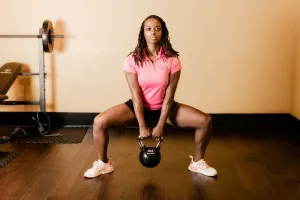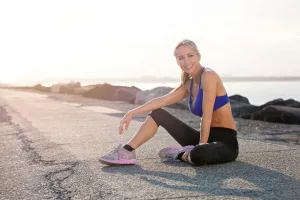Cork yoga blocks have become increasingly popular in the yoga community as a supportive prop for various yoga poses and practices. Their unique properties and benefits make them a valuable addition to any yogi’s toolkit. Let’s dive deeper into why cork yoga blocks are such a fantastic choice and how they can enhance your practice.
Benefits of Cork Yoga Blocks
One of the main benefits of using cork yoga blocks is their firm yet comfortable support. This firmness provides stability, which is crucial for maintaining proper alignment in poses. Whether you’re a beginner finding your footing or an advanced practitioner refining your form, cork blocks offer the necessary support. The natural texture of cork gives it a better grip than some other materials, allowing for a more secure and confident practice. This is particularly beneficial in poses like Trikonasana (Triangle Pose) or Ardha Chandrasana (Half Moon Pose), where balance is key.
Enhancing Stability and Alignment
Cork blocks help create a solid foundation. For instance, in Utthita Parsvakonasana (Extended Side Angle Pose), placing a cork block under your hand can help maintain alignment and prevent overstretching. The stability offered by cork blocks can also support deeper stretches by allowing you to hold poses longer with proper form.
In my own practice, I’ve found that using cork blocks in Parivrtta Trikonasana (Revolved Triangle Pose) allows for a smoother rotation and better alignment of the hips, which can be challenging without support. This is especially helpful for those with tight hamstrings or lower back issues.
Durability and Longevity
Cork is known for its durability. Unlike foam blocks that might wear down or lose shape over time, cork blocks maintain their integrity through countless sessions. This makes them a worthwhile investment for anyone serious about their yoga practice. A survey of yoga practitioners indicated that those using cork blocks reported less wear and tear over a year compared to those using foam blocks.
From personal observation, the cork blocks I’ve used for over five years show minimal signs of wear, maintaining their structure and grip as if they were new. This longevity not only saves money in the long run but also reduces waste, aligning with eco-conscious values.
Material Properties of Cork
Cork is a natural material with unique properties that make it an excellent choice for yoga blocks. It is lightweight, making it easy to transport to and from yoga classes or retreats. The non-slip surface of cork blocks is especially beneficial during hot yoga sessions or when practicing vigorous flows. This feature helps prevent slipping and sliding, which is especially important during poses like Adho Mukha Svanasana (Downward-Facing Dog), where traction is crucial.
Natural Antimicrobial Properties
Cork is naturally antimicrobial, meaning it resists the growth of bacteria and odors. This keeps your yoga equipment hygienic and clean, a significant advantage for those who practice frequently or in group settings. Unlike foam blocks, which can absorb sweat and odors, cork blocks remain fresh with minimal maintenance.
To maintain their freshness, simply wipe your cork blocks with a damp cloth and let them air dry. This easy maintenance routine is a boon for busy yogis who want to keep their practice clean without extra hassle.
Environmental Sustainability
Another advantage of cork yoga blocks is their eco-friendly nature. Cork is a renewable resource harvested from the bark of cork oak trees without harming the tree. This makes it a sustainable choice for eco-conscious practitioners. By opting for cork yoga blocks, yogis can reduce their environmental impact and contribute to forest conservation.
Sustainable Harvesting Practices
The harvesting process of cork is gentle and sustainable. Cork oak trees are not cut down; instead, their bark is carefully stripped every nine years. This process not only preserves the tree but also encourages its growth. This sustainable practice aligns with the principles of a holistic yoga practice that extends to caring for the planet.
In Portugal, where most of the world’s cork is harvested, cork forests are a vital part of the ecosystem, supporting biodiversity and providing a habitat for various species. By choosing cork products, you’re supporting these ecosystems and promoting environmental balance.
Low-Impact Production
The production of cork blocks is generally low in environmental impact. The process uses minimal chemicals and energy, reducing the overall carbon footprint. This makes cork blocks a responsible choice for those looking to align their yoga practice with their environmental values.
A deeper dive into the production process reveals that cork manufacturing often utilizes waste from other cork products, such as wine stoppers, ensuring minimal wastage and efficient use of resources. This circular approach further emphasizes the sustainability of cork products.
Comparing Cork to Foam Blocks
When comparing cork yoga blocks to foam blocks, cork blocks are generally considered more supportive and stable. Their density and non-compressible nature make them ideal for poses that require firmness. Foam blocks, while softer, may not provide the same level of support, which can be a drawback in certain poses.
Consistency and Reliability
Cork blocks are less likely to deform or lose shape over time, ensuring consistent support and stability throughout your practice. This reliability is crucial for maintaining a safe practice, particularly in challenging poses like Virabhadrasana III (Warrior III), where balance and support are essential.
As someone who has used both types of blocks, I can attest that cork blocks’ consistency enhances confidence, especially in balancing poses. The peace of mind that comes with knowing your support won’t falter is invaluable during practice.
Environmental Impact
Cork is a more sustainable material than foam. Foam blocks are often made from non-renewable resources and can contribute to environmental pollution during production and disposal. In contrast, cork is biodegradable and less harmful to the environment, aligning with the eco-conscious mindset of many yogis.
Choosing cork over foam is a simple yet impactful decision that can significantly reduce your carbon footprint. It’s a testament to how small choices in our practice can reflect larger values of environmental stewardship.
Practical Tips for Using Cork Yoga Blocks
To get the most out of your cork yoga blocks, consider these practical tips:
- Start with Basic Poses: If you’re new to yoga or using blocks, begin with basic poses like Seated Forward Fold or Bridge Pose. Place the block at different heights to find what feels most comfortable and supportive.
- Experiment with Heights: Cork blocks typically come with three height options: low, medium, and high. Use these different heights to modify poses according to your flexibility and comfort level. For instance, in Standing Forward Bend, a higher block can provide more support if your hamstrings are tight.
- Incorporate into Core Work: Use cork blocks to challenge your core. Place a block between your thighs during Boat Pose to engage inner thighs and core muscles, adding intensity to your workout.
- Support Restorative Poses: In restorative yoga, cork blocks can be used to support the body in poses like Reclined Bound Angle Pose. This can help deepen relaxation by allowing the body to release tension without effort.
- Use for Support in Inversions: Cork blocks can be particularly helpful when attempting inversions like Supported Headstand by providing a stable base for your shoulders.
- Facilitate Gentle Backbends: For a gentle backbend, place a cork block under your sacrum in Bridge Pose to open the front body without strain.
Common Mistakes and How to Avoid Them
While cork yoga blocks are incredibly beneficial, there are a few common mistakes practitioners make:
- Over-reliance: Some yogis rely too much on blocks, which can prevent the development of strength and flexibility. Use blocks to support but also challenge yourself to reduce dependence over time.
- Incorrect Placement: Ensure blocks are placed securely and flat on the ground to prevent slipping. This is particularly important in standing poses where balance is critical.
- Not Using Blocks at All: Some practitioners avoid blocks thinking they indicate weakness. However, blocks are tools for enhancing practice and should be used to support growth and prevent injury.
- Using Worn Blocks: Regularly check your blocks for wear and tear. Even the durable cork can degrade over time, especially if not cared for properly. Replace them if they lose their grip or shape.
Case Studies and Real-Life Examples
Consider the story of Sarah, a yoga teacher who integrated cork blocks into her teaching after discovering their benefits. Initially skeptical, she found that her students, especially beginners, gained confidence and improved alignment with the use of cork blocks. Her advanced students also appreciated the stability during challenging poses.
Another example is Jake, an athlete who turned to yoga to complement his training. He found cork blocks essential for modifying poses to accommodate his tight muscles, enabling him to gradually build flexibility and reduce injury risk.
These stories highlight the versatility and adaptability of cork blocks across different levels of practice and physical conditions, underscoring their role as an essential tool in any yogi’s practice.
Expanding Your Practice with Cork Blocks
Incorporating cork yoga blocks into your practice opens up a world of possibilities. Here are some creative ways to expand your yoga routine:
- Dynamic Flow Enhancements: Use blocks to create dynamic transitions between poses. For instance, moving from High Lunge to Warrior III with a block can improve stability and engage different muscle groups.
- Mindful Meditation Aid: Use a block to support your hips during seated meditation, promoting better posture and comfort for longer sessions.
- Assisted Strength Training: Incorporate blocks into strength-building exercises, such as using them as resistance in arm workouts to enhance muscle engagement.
Conclusion
Cork yoga blocks are a supportive and sustainable prop that can enhance your yoga practice by providing stability, comfort, and alignment assistance. With their unique material properties and eco-friendly benefits, cork blocks are a popular choice for yogis looking to deepen their practice. Investing in cork yoga blocks not only improves your yoga experience but also aligns with your values of sustainability and environmental consciousness, creating a harmonious connection between your practice and the world around you.
By incorporating cork yoga blocks into your practice, you embrace a holistic approach that supports your physical journey and contributes positively to the environment. Whether you’re just starting or looking to refine your practice, cork blocks offer a reliable and eco-conscious choice that harmonizes with the principles of yoga.
Expanding your practice with cork blocks not only enhances your physical capabilities but also resonates with a broader commitment to environmental stewardship and personal growth. The choice to use cork blocks is more than just a practical decision; it is an affirmation of values that transcend the mat, fostering a connection between individual wellness and planetary health.



